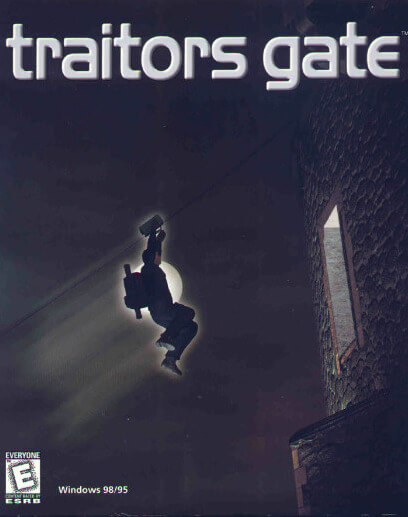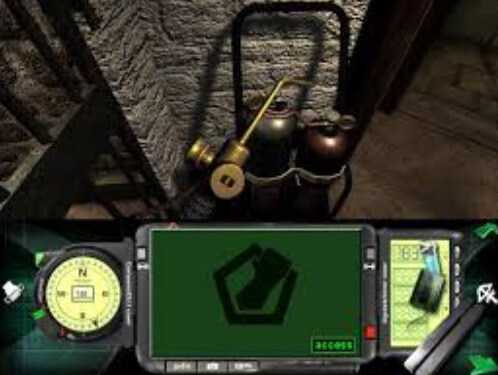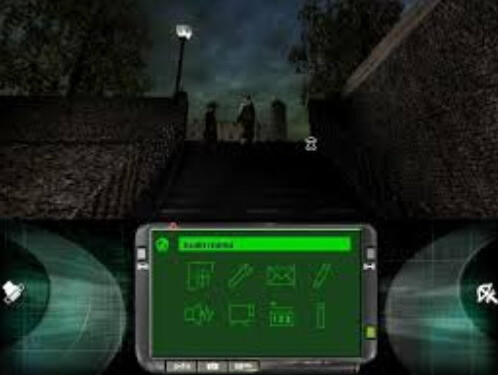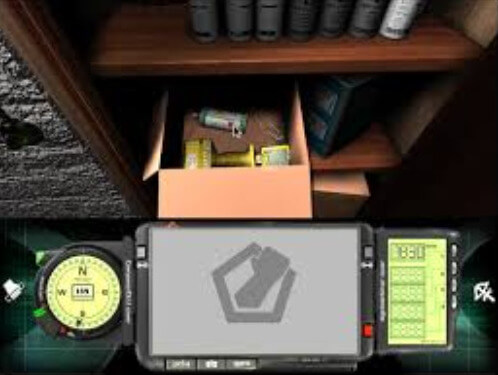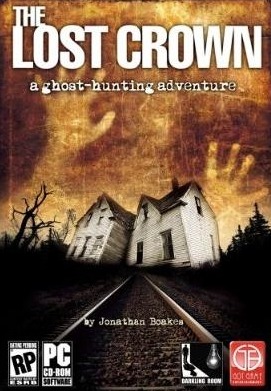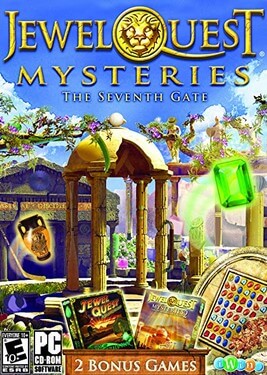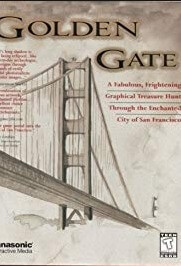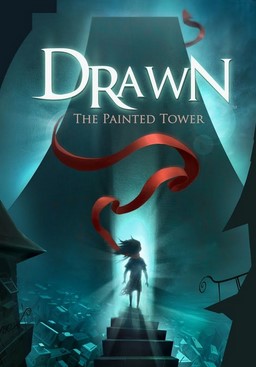Traitors Gate is a graphic adventure game that takes place from a first-person perspective in a pre-rendered visual environment. Using a point-and-click interface, the player explores a reproduction of the Tower of London and evades guards while solving puzzles, such as determining the combination to a safe by examining a coat of arms. In a manner that has been compared to Myst, player movement is restricted to jumps between panoramic static screens; the camera view can rotate freely on each screen. Traitors Gate features nonlinear progression: multiple solutions allow for roughly 1,200 unique pathways through the game. If the player does not win within the 12-hour limit, or is found by the guards, a game over results.
In Traitors Gate, the player takes the role of a special agent named Raven, employed by an American agency called ORPHIA. At the start of the game, Raven's superiors believe that another ORPHIA operative plans to steal the British Crown Jewels from the Tower of London. Raven is subsequently tasked with infiltrating the Tower, secretly swapping the real jewels with forgeries and escaping without leaving behind evidence. These forgeries are equipped with hidden tracking units. The game begins in a broom closet within the White Tower, where Raven hides during a building tour to await night. Controlling Raven, the player then exits the closet and infiltrates the Tower.
The player character is equipped with gear such as a crossbow, grappling hooks, lock picks, a motorized zip-line, explosives and tools to hijack security cameras. A PDA interface provides details about these gadgets, the Tower and other aspects of the mission. The player may also take photographs of the environment and message them to Raven's superiors, who send back facts about the objects in view. Traitors Gate features multiple endings based on the player's actions throughout the game. At the game's conclusion, after the Crown Jewels have been replaced, the President of the United States is informed that Raven's mission was a success.
Development
Origins
Traitors Gate was conceived in November 1996, when designer Nigel Papworth of Sweden's Daydream Software began to explore possibilities for the company's next title after Safecracker. Coming across an article about the Tower of London in an issue of National Geographic, Papworth realized that the structure contained "everything a good game needed", including a cleanly circumscribed playing area and an obvious gameplay objective. He and the team subsequently developed a game concept that would take place inside an accurate reproduction of the Tower. Their plan was to capture "the feel of the weathered stonework and mixed architectural styles with as near to photographic quality as time and technology would allow", and they hoped to make a game that entertained players while informing them about the real-world Tower. The decision to make the protagonist an American agent came early, as the country's alliance with Britain precluded violent gameplay approaches by the player and shifted the focus to stealth and puzzle-solving. Inspiration for the plot derived from the film series Mission: Impossible and James Bond.
Daydream went public on the Stockholm Stock Exchange's Stockholm Börsinformation (SBI) list in January 1997, with the plan for Traitors Gate prepared. The company's goal was to increase its economic and decision-making freedom, and to secure the ability to select a publisher at the end of each game's development rather than at the beginning. President Jan Phersson-Broburg argued that self-funding Daydream's future games with money from Swedish investors—instead of opting for publisher financing "linked to specific projects"—would offer the developer more stability, flexibility and room for growth. According to Papworth, Traitors Gate was part of Daydream's roadmap for the future after going public. In its November 1996 prospectus, the company had told investors that a game with the working title "Project II" was under development, with an estimated 18-month production cycle and 7-10 million kr budget. There were four competing "Project II" designs at that time. For Daydream's public launch, roughly 20 million kr worth of shares, or 45.5% of the company, were offered to investors in Sweden. The initial public offering was a success. As a result of this influx of capital, all subsequent development of Traitors Gate was self-funded.
Reception
Sales and distribution
Traitors Gate was commercially successful and became Daydream Software's top-selling game by 2003. It sold 48,000 units worldwide by the end of May 2000, and was a hit in Spain, which accounted for 22,000 sales by April 10. The game spent over three months in the top 10 of Spain's sales charts. However, it was a commercial failure in Germany, where it sold 4,000 copies; in the United Kingdom, which bought 3,000 units; and in Italy. The European Foundation for the Improvement of Living and Working Conditions (Eurofound) traced Traitors Gate's country-by-country success rate to the quality of Daydream's distribution partners in each region. By September 30, worldwide sales of the game had risen to roughly 120,000 copies. Daydream told investors that the jump from May came due to "increased marketing efforts by us and our distributors."
Writing for Adventure Gamers, Marek Bronstring noted that "slow" initial sales for Traitors Gate gave way to significant success, beginning around one year into its shelf life. September 2000 became the first-ever month that Daydream turned a net profit, in part thanks to the sales increase of Traitors Gate. The game surpassed 200,000 units sold globally by the end of March 2001 and reached close to 250,000 sales by June 30. That July, it topped 50,000 lifetime sales in Spain. According to the Eurofound, Traitors Gate was also successful in the United States, which the group wrote was "primarily because a huge supermarket chain" in the region had opted to stock it. It accounted for 14% of DreamCatcher Interactive's sales in 2000. This made it one of the publisher's top titles that year, behind Atlantis II and The Crystal Key. The following year, PC Data calculated the game's retail sales in North America at 52,573 units for 2001 alone.
Globally, Traitors Gate sold more than 300,000 copies by March 2002. During the first six months of that year, PC Data tracked another 15,429 sales in North American retailers. By 2003, Traitors Gate had sold between 300,000 and 400,000 copies worldwide, of which Spain accounted for 75,000 units. According to DreamCatcher, the game totaled 245,000 lifetime sales in North America alone by early 2003.
Critical reviews
According to the review aggregation site Metacritic, critical reception of Traitors Gate was "mixed or average". The game was nominated for "The Design Award" at the 1999 British Academy Film Awards (BAFTAs), but lost the prize to Wipeout 3. The BAFTAs' judges called Traitors Gate a "very well researched and well considered game with intuitive game play", and praised its controls and its depiction of the Tower of London. It was also a finalist for GameSpot's 2000 "Best Adventure Game" award, which ultimately went to The Longest Journey.
Comparing the game to Spycraft: The Great Game, GameSpot's Ron Dulin praised the puzzles in Traitors Gate, which he felt were sensible and realistic, alongside its detailed reproduction of the Tower of London. Despite encountering numerous technical problems with the software, he considered the overall product "very good", but short of outstanding. Cal Jones of PC Gaming World similarly praised the puzzles and visual detail, but noted a slight blurriness to the graphics and found the game brief despite its "nice covert feel". She ultimately gave it a moderate rating.
